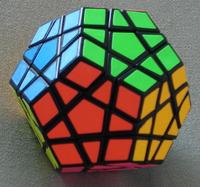
The Rubik's Cube is a 3D combination puzzle invented in 1974 by Hungarian sculptor and professor of architecture Ernő Rubik. Originally called the Magic Cube, the puzzle was licensed by Rubik to be sold by Pentangle Puzzles in the UK in 1978, and then by Ideal Toy Corp in 1980 via businessman Tibor Laczi and Seven Towns founder Tom Kremer. The cube was released internationally in 1980 and became one of the most recognized icons in popular culture. It won the 1980 German Game of the Year special award for Best Puzzle. As of January 2024, around 500 million cubes had been sold worldwide, making it the world's bestselling puzzle game and bestselling toy. The Rubik's Cube was inducted into the US National Toy Hall of Fame in 2014.

A yo-yo is a toy consisting of an axle connected to two disks, and a string looped around the axle, similar to a spool. It is an ancient toy with proof of existence since 440 BC. The yo-yo was also called a bandalore in the 17th century.
An action figure is a poseable character model figure made most commonly of plastic, and often based upon characters from a film, comic book, military, video game or television program; fictional or historical. These figures are usually marketed toward boys and adult collectors. The term was coined by Hasbro in 1964 to market G.I. Joe to boys.

A ball bearing is a type of rolling-element bearing that uses balls to maintain the separation between the bearing races.

A bearing is a machine element that constrains relative motion to only the desired motion and reduces friction between moving parts. The design of the bearing may, for example, provide for free linear movement of the moving part or for free rotation around a fixed axis; or, it may prevent a motion by controlling the vectors of normal forces that bear on the moving parts. Most bearings facilitate the desired motion by minimizing friction. Bearings are classified broadly according to the type of operation, the motions allowed, or the directions of the loads (forces) applied to the parts.

The diabolo is a juggling or circus prop consisting of an axle and two cups or discs derived from the Chinese yo-yo. This object is spun using a string attached to two hand sticks. A large variety of tricks is possible with the diabolo, including tosses, and various types of interaction with the sticks, string, and various parts of the user's body. Multiple diabolos can be spun on a single string.

The Rubik's Revenge is a 4×4×4 version of the Rubik's Cube. It was released in 1981. Invented by Péter Sebestény, the cube was nearly called the Sebestény Cube until a somewhat last-minute decision changed the puzzle's name to attract fans of the original Rubik's Cube. Unlike the original puzzle, it has no fixed faces: the center faces are free to move to different positions.

A plain bearing, or more commonly sliding contact bearing and slide bearing, is the simplest type of bearing, comprising just a bearing surface and no rolling elements. Therefore, the journal slides over the bearing surface. The simplest example of a plain bearing is a shaft rotating in a hole. A simple linear bearing can be a pair of flat surfaces designed to allow motion; e.g., a drawer and the slides it rests on or the ways on the bed of a lathe.

In mechanical engineering, a rolling-element bearing, also known as a rolling bearing, is a bearing which carries a load by placing rolling elements between two concentric, grooved rings called races. The relative motion of the races causes the rolling elements to roll with very little rolling resistance and with little sliding.

Polyoxymethylene (POM), also known as acetal, polyacetal, and polyformaldehyde, is an engineering thermoplastic used in precision parts requiring high stiffness, low friction, and excellent dimensional stability. As with many other synthetic polymers, it is produced by different chemical firms with slightly different formulas and sold variously by such names as Delrin, Kocetal, Ultraform, Celcon, Ramtal, Duracon, Kepital, Polypenco, Tenac and Hostaform.

The National Toy Hall of Fame is a U.S. hall of fame that recognizes the contributions of toys and games that have sustained their popularity for many years. Criteria for induction include: icon status ; longevity ; discovery ; and innovation. Established in 1998 under the direction of Ed Sobey, it was originally housed at A. C. Gilbert's Discovery Village in Salem, Oregon, United States, but was moved to the Strong National Museum of Play in Rochester, New York, in 2002 after it outgrew its original home.

The Megaminx or Mégaminx is a dodecahedron-shaped puzzle similar to the Rubik's Cube. It has a total of 50 movable pieces to rearrange, compared to the 20 movable pieces of the Rubik's Cube.

Astrojax, invented in 1986 by Larry Shaw, is a toy consisting of three balls on a string. In the original version of the toy, one ball is fixed at each end of the string, and the center ball is free to slide along the string between the two end balls. Inside each ball is a metal weight. The metal weight lowers the moment of inertia of the center ball so it can rotate rapidly in response to torques applied by the string. This prevents the string from snagging or tangling around the center ball.

A fly system, or theatrical rigging system, is a system of ropes, pulleys, counterweights and related devices within a theater that enables a stage crew to fly (hoist) quickly, quietly and safely components such as curtains, lights, scenery, stage effects and, sometimes, people. Systems are typically designed to fly components between clear view of the audience and out of view, into the large space, the fly loft, above the stage.
A linear-motion bearing or linear slide is a bearing designed to provide free motion in one direction. There are many different types of linear motion bearings.
Steve Brown is an American competitive yo-yo player, competition judge, yo-yo designer, and yoyo blogger currently based out of North Olmsted, Ohio. He is currently the editor for YoYoNews.com and a co-producer of the Triple Crown of YoYo events. In 2001, the National Yo-Yo League named him as one of eight National Yo-Yo masters. He has designed multiple yo-yos, including the "Cherry Bomb" for Team Losi. While employed by Duncan Toys Company as marketing and promotions coordinator, Brown invented and patented freehand yo-yo play where instead of being attached to the finger, the string is actually attached to a counterweight, and designed a line of yo-yos for the new style. He also authored a book called Duncan Yo-Yo Trick Book while employed by the company.

The Void Cube is a 2-D mechanical puzzle similar to a Rubik's Cube, with the notable difference being that the center pieces are missing, which causes the puzzle to resemble a level 1 Menger sponge. The core used on the Rubik's Cube is also absent, creating holes straight through the cube on all three axes. Due to the restricted volume of the puzzle it employs an entirely different structural mechanism from a regular Rubik's Cube, though the possible moves are the same. The Void Cube was invented by Katsuhiko Okamoto. Gentosha Education, in Japan, holds the license to manufacture official Void Cubes. These official designs are also sold under the Rubik's brand, owned by Spin Master Ltd., and workalikes are available from a variety of manufacturers. Speed-solving the Void Cube is common in exhibition but is not an official World Cube Association competition event.

Pan dulce, literally meaning "sweet bread", is the general name for a variety of Mexican pastries. They are inexpensive treats and are consumed at breakfast, merienda, or dinner. The pastries originated in Mexico following the introduction of wheat during the Spanish conquest of the Americas and developed into many varieties thanks to French influences in the 19th century.

The Gear Cube is a 3-D combination puzzle designed and created by Dutch puzzle maker Oskar van Deventer based on an idea by Bram Cohen. It was initially produced by Shapeways in 2009 and known as "Caution Cube" due to the likelihood of getting one's fingers stuck between the gears while speedcubing. Later, in 2010, it was mass-produced by Meffert's as the "Gear Cube".
















